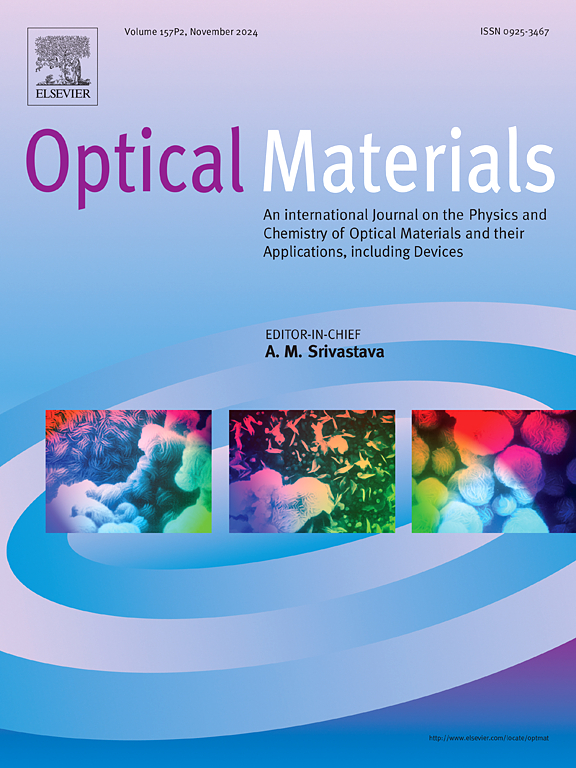Thermal protection of wearable devices under outdoor conditions using radiative cooling films
IF 3.8
3区 材料科学
Q2 MATERIALS SCIENCE, MULTIDISCIPLINARY
引用次数: 0
Abstract
Wearable electronic devices operating outdoors are vulnerable to overheating under prolonged exposure to intense solar radiation and elevated ambient temperatures. Such thermal stress compromises device performance, inducing functional failure, and poses safety risks such as skin burns. Therefore, we developed a passive radiative cooling film (RCF) providing energy-free thermal management for wearable electronics. The RCF, fabricated via electrospinning of a polyvinyl alcohol matrix embedded with silicon dioxide (SiO2) and aluminum oxide (Al2O3) nanoparticles, exhibits optimized optical properties, including a high average solar reflectance of 0.88 (0.3–2.5 μm) and thermal emissivity of 0.95 in the atmospheric window (8–13 μm). These properties enable effective radiative heat dissipation and reduce the solar heat gain. Under high-temperature outdoor conditions, RCF-integrated wearable sensors maintained an average surface temperature of 42.5 °C, which was up to 8.6 °C lower than that of sensors without the film, ensuring stable operation without thermal failure. Additionally, the RCF effectively mitigated thermal accumulation in smartphone batteries, reducing peak surface temperature from 60.0 °C to 37.1 °C under direct sunlight. These results demonstrate the potential of the RCF as a scalable and energy-efficient solution for enhancing thermal reliability and user safety of next-generation wearable outdoor electronic devices.
使用辐射冷却膜的可穿戴设备在室外条件下的热保护
在户外工作的可穿戴电子设备在长时间暴露于强烈的太阳辐射和升高的环境温度下很容易过热。这种热应力会影响设备性能,诱发功能故障,并带来皮肤烧伤等安全风险。因此,我们开发了一种被动辐射冷却膜(RCF),为可穿戴电子产品提供无能量的热管理。通过静电纺丝将聚乙烯醇基体嵌入二氧化硅(SiO2)和氧化铝(Al2O3)纳米颗粒制备的RCF具有优化的光学性能,在大气窗口(8-13 μm)内平均太阳反射率为0.88 (0.3-2.5 μm),热发射率为0.95。这些特性使有效的辐射散热和减少太阳热增益。在室外高温条件下,集成rcf的可穿戴传感器的平均表面温度保持在42.5℃,比未使用薄膜的传感器的平均表面温度降低了8.6℃,确保了传感器的稳定运行而不会出现热故障。此外,RCF有效地减少了智能手机电池的热积累,在阳光直射下将峰值表面温度从60.0°C降低到37.1°C。这些结果证明了RCF作为一种可扩展的节能解决方案的潜力,可以提高下一代可穿戴户外电子设备的热可靠性和用户安全性。
本文章由计算机程序翻译,如有差异,请以英文原文为准。
求助全文
约1分钟内获得全文
求助全文
来源期刊

Optical Materials
工程技术-材料科学:综合
CiteScore
6.60
自引率
12.80%
发文量
1265
审稿时长
38 days
期刊介绍:
Optical Materials has an open access mirror journal Optical Materials: X, sharing the same aims and scope, editorial team, submission system and rigorous peer review.
The purpose of Optical Materials is to provide a means of communication and technology transfer between researchers who are interested in materials for potential device applications. The journal publishes original papers and review articles on the design, synthesis, characterisation and applications of optical materials.
OPTICAL MATERIALS focuses on:
• Optical Properties of Material Systems;
• The Materials Aspects of Optical Phenomena;
• The Materials Aspects of Devices and Applications.
Authors can submit separate research elements describing their data to Data in Brief and methods to Methods X.
 求助内容:
求助内容: 应助结果提醒方式:
应助结果提醒方式:


